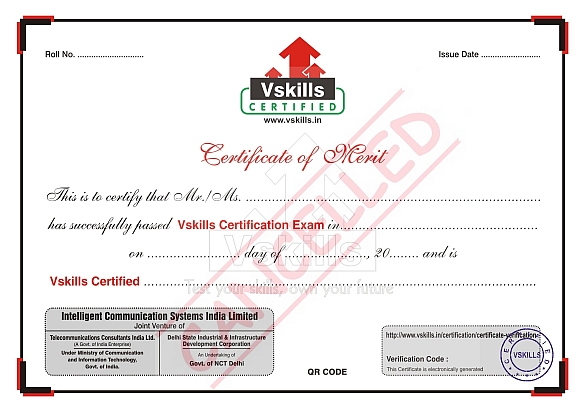- Duration / Course length: 1 To 2 Months Start now
- Certificates:
- Course delivery: This course is delivered in video format
Course details
Vskills certification for Textile Designer assesses the candidate as per the company’s need for designing garments with variation in color, fabric and texture. The certification tests the candidates on various areas in textile basics, textile production methods, textile printing, embroidery stitching and Indian textile techniques like Chikankari, Phulkari and Bandhani.Why should one take this certification?
This Course is intended for professionals and graduates wanting to excel in their chosen areas. It is also well suited for those who are already working and would like to take certification for further career progression.
Earning Vskills Textile Designer Certification can help candidate differentiate in today's competitive job market, broaden their employment opportunities by displaying their advanced skills, and result in higher earning potential.
Who will benefit from taking this certification?
Job seekers looking to find employment in textile design, sale, production and quality control departments of various companies, students generally wanting to improve their skill set and make their CV stronger and existing employees looking for a better role can prove their employers the value of their skills through this certification.
Companies that hire Vskills Textile Designer
Textile Designers are in great demand. Companies specializing in textile production, design or sale are constantly hiring skilled textile designers. Various public and private companies also need textile designer for their textile design, sale, production and quality control departments.
Table of Contents
Textile
- Etymology
- History
- Textile Evolution
- End Uses
- Fashion and Textile Designers
- Fiber Classification and Properties
- Production Methods
- Textile Treatments
- Digital Printing
- Digital Printing Methods
- Digital Laser Exposure
- Basics
- Historic Figures
- Textile Designer Role
- Functions of Textile Designer
- The Design Process
- Design Elements
- Principles of Design
- Historical Background
- Color Abstractions
- Complementary Colors
- Warm vs. cool colors
- Achromatic Colors
- Tints and shades
- Split Primary Colors
- Color Harmony
- Current Status
- Basic Techniques for Creating Color Schemes
- Yarn Forms
- Yarn Type
- Characteristics of Spun Yarns and Filament Yarns
- Structure
- Colour
- Measurement
- Yarn Numbering System
- Properties of Sewing Threads
- Introduction
- Importance of Grain
- Shrinkage
- Straightening of Fabric
- Marking and Cutting Fabric
- Technology
- Methods of Printing
- Engraved Copperplate Printing
- Digital Textile Printing
- Preparation of Cloth for Printing
- Preparation of Colours
- Selecting Thickening Agents
- Albumen
- Printing thickeners and the dye system
- Etymology
- Origins and History
- Sari outside South Asia
- Types of sari
- Styles of Draping Sari
- Common Stitches
- Embroidery Stitches
- Straight Stitches
- Back stitches
- Chain stitches
- Feather Stitches
- Cross Stitches
- Knotted Stitches
- Introduction
- Types
- Finishes
- Position
- Origin
- Technique
- History of Chikankari
- Fabric
- Design
- Threads
- Embroidery
- Thirma
- Bawan Bagh (or Bawan Phulkari)
- Some of the most common designs are
- Dyed Textile- Popular Dyes
- Bandhani and City of Wadhwan
- Cutting cloth
- Origins
- Processes
- Common Dyestuffs
- Natural dyeing with Indigo, Jaipur (Rajasthan, India)
- Crimson and Scarlet
- The Rise of Formal Black
- Decline and Rediscovery
- Introduction
- Intellectual Property Law in India
- Patents
- Trademarks
- Copyrights
- Copyright Act, 1957
- Industrial Design
- Designs Act, 2000





